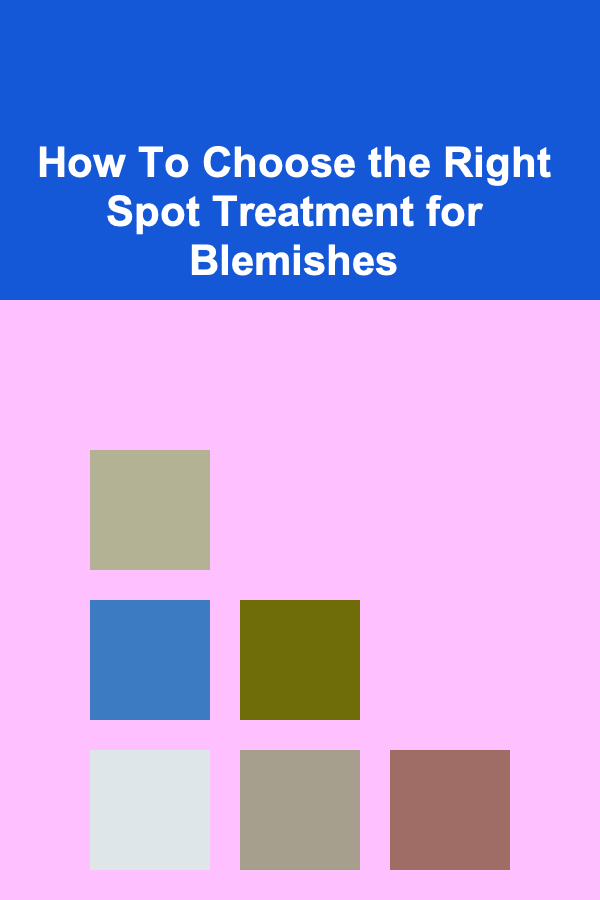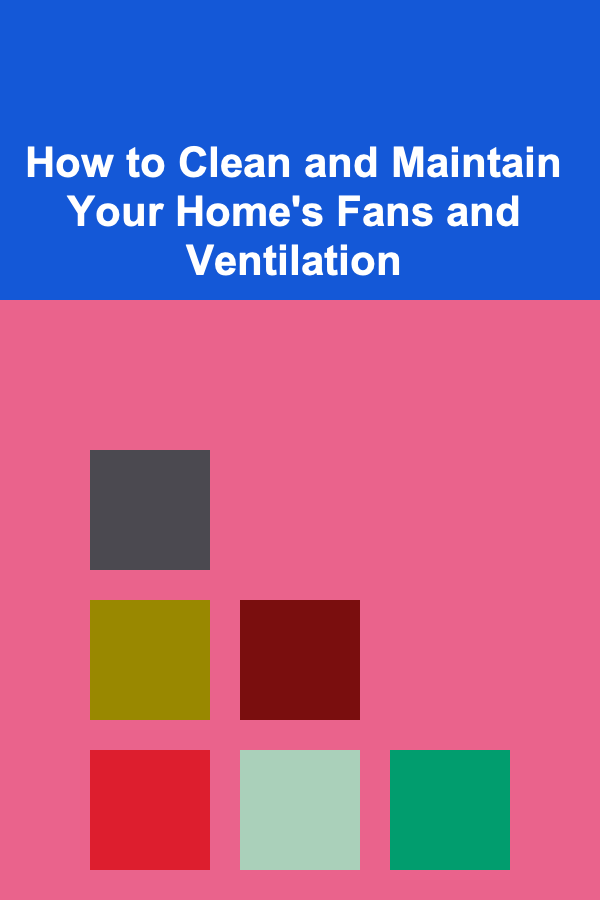
How To Choose the Right Spot Treatment for Blemishes
ebook include PDF & Audio bundle (Micro Guide)
$12.99$9.99
Limited Time Offer! Order within the next:

Blemishes are a common skin issue that many people face at some point in their lives. They can take various forms, including acne, pimples, blackheads, whiteheads, and dark spots, often making us feel self-conscious. Spot treatments are a popular solution for targeting blemishes, but with so many options available, it can be overwhelming to figure out which one will work best for you.
This article provides a comprehensive guide on how to choose the right spot treatment for blemishes. We will cover the different types of blemishes, how spot treatments work, the ingredients to look for, how to choose based on skin type, and additional tips for managing blemishes effectively.
Understanding Blemishes and Their Causes
Before diving into the world of spot treatments, it's important to understand what blemishes are and what causes them. Blemishes can vary in appearance and severity, but they all share a common origin: clogged pores.
Types of Blemishes
- Acne: Acne can appear as pimples, cysts, or pustules and is caused by the overproduction of oil in the skin, combined with dead skin cells and bacteria clogging the pores. Acne can be hormonal, genetic, or triggered by environmental factors.
- Pimples: These are small, red, inflamed spots that can form when the pores become clogged with excess oil and bacteria.
- Blackheads: These occur when pores become clogged with oil and dead skin cells, but unlike pimples, the blockage is exposed to air, causing it to oxidize and turn black.
- Whiteheads: Similar to blackheads, whiteheads form when pores are clogged, but unlike blackheads, the blockage remains closed, leading to the formation of a small white or flesh-colored bump.
- Dark Spots (Hyperpigmentation): These are typically a result of inflammation caused by acne or other skin irritation. They appear as dark patches or spots on the skin and can persist even after the blemish has healed.
Causes of Blemishes
The causes of blemishes are multi-faceted and can include:
- Hormonal Changes: Hormonal fluctuations during puberty, menstruation, pregnancy, or stress can trigger excess oil production, leading to clogged pores.
- Poor Skincare Routine: Using products that are too harsh or unsuitable for your skin type can irritate the skin and exacerbate blemishes.
- Diet: A diet high in processed foods, sugar, and dairy may contribute to acne in some individuals.
- Bacterial Growth : Bacteria, such as Propionibacterium acnes, thrive in clogged pores and can lead to inflamed blemishes.
How Spot Treatments Work
Spot treatments are designed to target individual blemishes, applying active ingredients directly to the affected area to reduce inflammation, kill bacteria, and accelerate healing. These treatments are more concentrated than general skincare products and work by delivering powerful ingredients to the problem spot.
Types of Spot Treatments
- Topical Creams or Gels: These are the most common types of spot treatments. They typically contain ingredients like benzoyl peroxide, salicylic acid, or sulfur, which help to reduce bacteria, clear clogged pores, and reduce inflammation.
- Patches: These adhesive patches are applied directly to the blemish and often contain ingredients like hydrocolloid, which absorbs excess fluid and speeds up the healing process. They can be worn overnight for continuous treatment.
- Roll-ons: These products are typically liquid and come in a small container with a rollerball applicator. They often contain ingredients like tea tree oil, salicylic acid, or witch hazel, and can be applied directly to the affected area.
Key Ingredients to Look For in Spot Treatments
The effectiveness of a spot treatment depends largely on the ingredients it contains. Different active ingredients work in different ways to address various types of blemishes.
1. Salicylic Acid
Salicylic acid is one of the most common and effective ingredients in spot treatments. It is a beta-hydroxy acid (BHA) that works by penetrating the pores and helping to dissolve the excess oil and dead skin cells that contribute to acne formation. Salicylic acid is particularly useful for treating blackheads, whiteheads, and mild acne. It has anti-inflammatory properties that help reduce redness and swelling around the blemish.
Best for: Acne, blackheads, whiteheads.
2. Benzoyl Peroxide
Benzoyl peroxide is another powerful ingredient commonly found in spot treatments. It works by killing the acne-causing bacteria Propionibacterium acnes that live inside clogged pores. Benzoyl peroxide can also help to reduce excess oil production, making it effective for individuals with oily skin.
However, benzoyl peroxide can be quite drying, so it's important to use it in moderation, particularly if you have sensitive skin.
Best for: Active acne, cystic acne.
3. Sulfur
Sulfur is an excellent treatment for oily, acne-prone skin. It works by absorbing excess oil, reducing redness and swelling, and unclogging pores. Sulfur is often used in combination with other active ingredients for enhanced results. It also has mild antibacterial properties, making it useful for treating blemishes caused by bacterial growth.
Best for: Acne, pimples, oily skin.
4. Tea Tree Oil
Tea tree oil is a natural alternative to harsher chemicals. It has anti-inflammatory and antimicrobial properties, which help reduce redness and prevent bacterial growth on the skin. Tea tree oil is particularly beneficial for individuals with sensitive skin, as it is gentler than benzoyl peroxide or salicylic acid.
Best for: Mild acne, sensitive skin.
5. Niacinamide
Niacinamide, also known as Vitamin B3, is an antioxidant that helps to calm inflammation and reduce redness. It can also help to regulate oil production, which makes it an excellent option for those with oily skin who are prone to acne. Niacinamide is also helpful for treating dark spots and hyperpigmentation left behind after acne.
Best for: Inflammation, post-acne scars, hyperpigmentation.
6. Retinoids (Retinol)
Retinoids, including retinol, are derivatives of Vitamin A that work by accelerating cell turnover and preventing pores from becoming clogged with dead skin cells. While retinoids are often used for long-term acne treatment, they can also be effective in spot treatments. However, they can cause dryness and irritation, so it's important to start slowly when using products with retinoids.
Best for: Cystic acne, blackheads, preventing future breakouts.
7. Witch Hazel
Witch hazel is a natural astringent that helps tighten the skin and reduce inflammation. It also has antibacterial properties, making it effective at preventing acne-causing bacteria from proliferating. Witch hazel can help soothe irritated skin and reduce swelling around blemishes.
Best for: Mild acne, skin irritation, redness.
Choosing the Right Spot Treatment for Your Skin Type
Not all spot treatments are suitable for every skin type, so it's important to choose one that aligns with your unique skin needs. Here's how to match the right spot treatment with your skin type:
1. Oily Skin
If you have oily skin, you'll likely benefit from spot treatments that contain salicylic acid or benzoyl peroxide. Both ingredients help reduce excess oil production and fight acne-causing bacteria. Look for treatments that are oil-free and non-comedogenic (won't clog pores).
2. Dry or Sensitive Skin
For dry or sensitive skin, it's essential to avoid overly harsh ingredients that can lead to irritation. Instead, opt for treatments that contain tea tree oil or niacinamide, which are gentle yet effective in reducing inflammation. You may also consider using products with sulfur, which absorb oil without being too harsh.
3. Combination Skin
Combination skin requires a balance of treatments that target both oily and dry areas. You can use salicylic acid on your T-zone (forehead, nose, chin) to control excess oil, while using gentler ingredients like niacinamide or tea tree oil on the drier areas of your face.
4. Acne-Prone Skin
If you have acne-prone skin, it's important to use treatments that contain ingredients like benzoyl peroxide, salicylic acid, or retinoids, which target the root causes of acne, such as clogged pores and bacterial growth. Regular use of these treatments can help prevent future breakouts and promote clearer skin.
Additional Tips for Managing Blemishes
- Don't Pick or Pop: It's tempting, but picking at blemishes can cause scarring and spread bacteria, worsening the issue. Avoid touching your face and let the spot treatment do its work.
- Consistency is Key: Spot treatments take time to show results. Be consistent with your treatment routine and give the product time to work before trying something else.
- Protect Your Skin: Use sunscreen daily, especially when using treatments that can make your skin more sensitive to the sun, such as benzoyl peroxide or retinoids.
- Stay Hydrated: Drinking plenty of water can help flush out toxins from your body, which can reduce the likelihood of blemishes forming.
Conclusion
Choosing the right spot treatment for blemishes is a personal decision that depends on your skin type, the nature of your blemishes, and the ingredients that work best for you. Whether you're dealing with acne, pimples, blackheads, or hyperpigmentation, there are spot treatments available that can effectively target these concerns.
By understanding the active ingredients, selecting the right treatment for your skin type, and maintaining a consistent skincare routine, you can reduce the appearance of blemishes and enjoy clearer, healthier skin.
Reading More From Our Other Websites
- [Scrapbooking Tip 101] Preserving Memories: How to Choose Paper, Glue, and Archival Materials
- [Gardening 101] Tool Storage Secrets: Protecting Your Equipment from Weather and Wear
- [Home Cleaning 101] How to Clean Your Refrigerator and Freezer Effectively
- [Personal Care Tips 101] How to Use Hair Mousse for a Soft, Touchable Finish
- [Personal Care Tips 101] How to Use Concealer for a Subtle, Natural Coverage
- [Organization Tip 101] Choosing the Best Chimney Cap Material for Long-Term Durability
- [Home Party Planning 101] How to Master the Art of Mixology and Create a Signature Cocktail for Your Next Gathering
- [Personal Care Tips 101] How to Deal with Acid Reflux Through Dietary Changes
- [Home Space Saving 101] How to Set Up a Space-saving Vertical Garden in Your Home
- [Organization Tip 101] How to Implement a Daily Cleaning Routine for Your Office

How to Clean and Maintain Your Home's Fans and Ventilation
Read More
How To Start Flyboarding: Hovering Over Water
Read More
How to Use Accounting Software to Streamline Your Services
Read More
How To Master Fingerstyle Ukulele
Read More
Intimacy Beyond Sex: Exploring All Forms of Connection
Read More
How to Choose the Right Jet Ski for Your Body Type
Read MoreOther Products

How to Clean and Maintain Your Home's Fans and Ventilation
Read More
How To Start Flyboarding: Hovering Over Water
Read More
How to Use Accounting Software to Streamline Your Services
Read More
How To Master Fingerstyle Ukulele
Read More
Intimacy Beyond Sex: Exploring All Forms of Connection
Read More